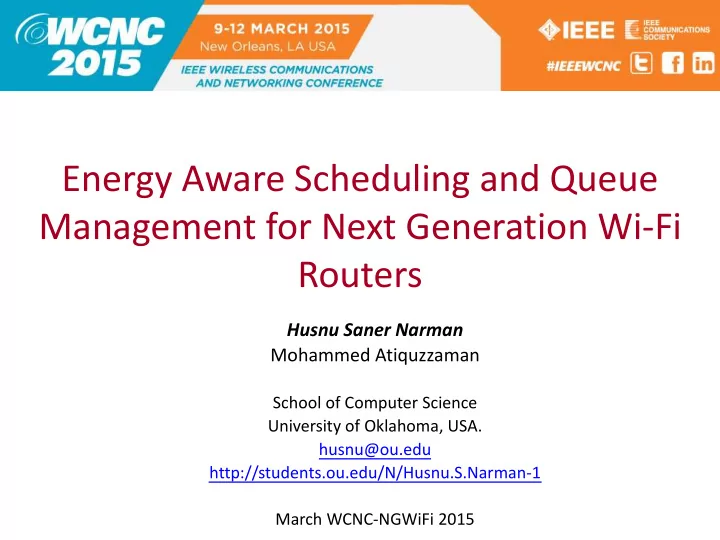

Energy Aware Scheduling and Queue Management for Next Generation Wi-Fi Routers Husnu S aner Narman Mohammed Atiquzzaman School of Computer Science University of Oklahoma, USA. husnu@ou.edu http://students.ou.edu/N/Husnu.S.Narman-1 March WCNC-NGWiFi 2015
Outline • Introduction • Multi Band Router Architecture • Energy Aware Algorithm • Results • Conclusion Husnu S. Narman
Wi-Fi (802.11) Over Generation 2.4, 5, 60 GHz Multi-band 7 Gbps OFDM 5 GHz 780 Mbps ad OFDM 2.4, 5 GHz 65, 135 Mbps ac OFDM Future Ones 2.4 GHz 2.4 GHz n ah: 0.9 GHz 1, 2 Mbps 11 Mbps aj: 45, 60 GHz a g DSSS,FHSS DSSS ax: 2.4, 5 GHz 5 GHz 2.4 GHz b 97 54 Mbps 54 Mbps OFDM DSSS,OFDM 3 Husnu S. Narman
Introduction Current Multi Band (802.11n generation) 1 st Band: 2.4 GHz Multiband Energy Result 2 nd Band: 5 GHz Conclusion The benefit of using multi-band router is less interference, higher capacity and better reliability. Husnu S. Narman 4
Introduction Current Multi-Band Queuing System 𝑅 𝑏 Multiband Band-a 𝑅 𝑐 Band-b Energy 𝑅 𝑑 Result Band-c Conclusion Husnu S. Narman 5
Introduction Multi-shared-band Router (Suggested) 2.4 GHz Multiband 5 GHz Energy 5 GHz Result 2.4 GHz Conclusion Husnu S. Narman 6
Introduction Multi-shared-band Queuing System Multiband 𝑅 𝑏 Band-a 𝑅 𝑐 Energy Band-b Result 𝑅 𝑑 Band-c Conclusion Husnu S. Narman 7
Introduction Current Multi-band and Multi-shared-band Routers objective • Energy consumption is high Wi-Fi – $27 per year for a router even for stand by (Ecotricity) LTE-A Conclusion Husnu S. Narman 8
Introduction Objective Multiband Energy Decreasing energy consumption of multi-band routers. Result Conclusion Husnu S. Narman 10
Introduction Current Solution for Energy Awareness • Channel selection based on power consumption by considering QoS. Multiband 2.45-2.55 GHz: 5 dB Energy 5.65-5.75 GHz: 10 dB Result • User has Antenna Selection in MIMO – Good for transferring data but not for stand by. Conclusion • Using small packets Husnu S. Narman 13
Introduction Proposed: Energy Aware Scheduling Algorithm and Queue Management (e-ASA) Multiband Energy • Follows sleep and wake-up procedure of bands Result • Depends on incoming traffic rates and QoS Conclusion Husnu S. Narman 15
Introduction e-ASA Based Multi-shared-band Queuing System Multiband 𝑅 𝑏 Band-a 𝜈 𝑏 𝑅 𝑐 Energy Band-b 𝜈 𝑐 Result 𝑅 𝑑 Band-c 𝜈 𝑑 Conclusion Husnu S. Narman 16
e-ASA Based Multi-shared-band Scheduling Introduction Based on active To increase The required Traffic Arrival and non active QoS, first send number of Multiband and Packet bands, the packets over band and transfer rate is communication Least Loaded buffer size is measured links are and highest CQI determined created. for each device Energy • • Packet Trans. 𝜇 𝑏𝑜𝑒 𝜈 Coverage • Exp. throughput 1 − 𝜍 𝐸 = 𝜍 𝑂 1 − 𝜍 𝑂+1 Result 𝛿 = 1 − 𝐸 Conclusion Expected throughput rate Husnu S. Narman 17
Introduction Energy Modeling • Energy modelling for only downloading Energy Multiband • Depends on idle or busyness of bands consumption during idle time Energy 𝐹 𝑏 = 𝑈 ∗ 𝛽 ∗ 𝜍 𝑏 + 𝛾 ∗ (1 − 𝜍 𝑏 ) Energy consumption Simulation Result Band is busy Band is idle during data transfer time time Conclusion 𝐹 = 𝐹 𝑏 + 𝐹 𝑐 + 𝐹 𝑑 Total energy consumption Husnu S. Narman 18
Conclusion Result Energy Multiband Introduction Husnu S. Narman Simulation Environments 19
Introduction Results Multiband • Discrete event simulation by following M/M/3/N. • 100 realizations for different number of users with increasing data traffic . Energy • We compare – Single (Single band router), Result – Current (Current multi band router), – Shared (Multi-shared-band router) Conclusion – Shared (e-ASA ) (Multi-shared-band with energy aware scheduling algorithm) Husnu S. Narman 20
Introduction Band Usage Objective Observing effects of number Multiband of users on band usage of all bands. Band Usages of Single and Energy e-ASA are same and lower than multi-band routers. Result Band Usages of e-ASA is changeable because of Conclusion dynamic allocation. Band usages of multi-band routers are lower. Husnu S. Narman 21
Introduction Throughput Rate Objective Observing effects of number Multiband of users on throughput rate. Energy Throughput rate of e-ASA and shared are higher than other cases. Result Conclusion e-ASA does not decrease the throughput rate Throughput rate of single comparing to multi-shared-band. are lower. Husnu S. Narman 22
Introduction Energy Consumption Objective Observing effects of number Multiband of users on energy usage. Energy Energy consumption of e- ASA is increasing because of number of users. Result Conclusion Energy consumption of e-ASA is lower than Energy usage of e-ASA and other multi-band routers except when three single are same for low bands are fully used. number of users. Husnu S. Narman 23
Introduction Summary of Results Improving throughput rate of multi-band up to 20% Multiband Multi-shared-band Energy with e-ASA Result Conclusion Up to 60% energy can be saved by using e-ASA. 24 Husnu S. Narman
Conclusion Result Energy Multiband Introduction Husnu S. Narman Conclusion 25
Thank You http://students.ou.edu/N/Husnu.S.Narman-1 husnu@ou.edu 26 Husnu S. Narman
Recommend
More recommend